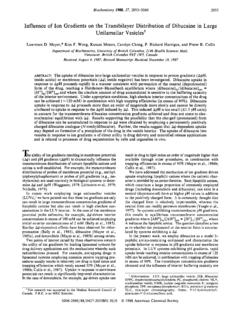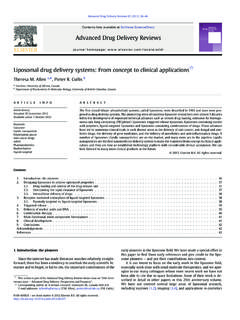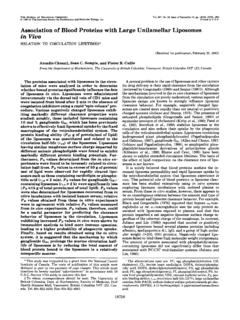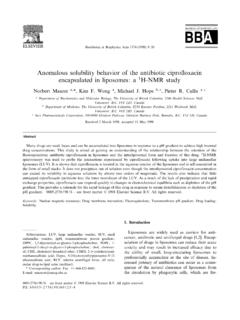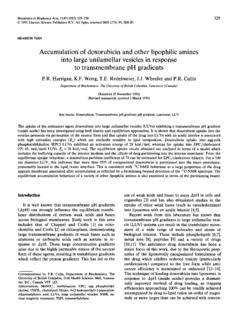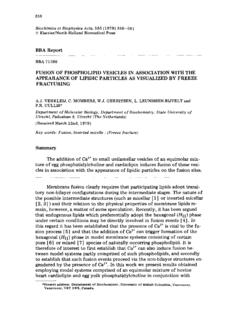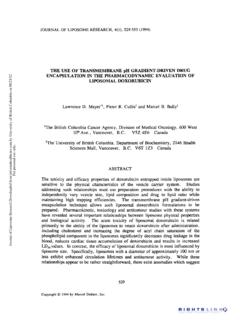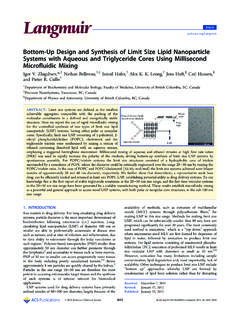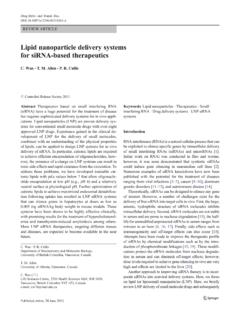Transcription of Polymorphic Phase Behavior of Unsaturated ...
1 816 Biochemistry 1986, 25, 8 16-822 Polymorphic Phase Behavior of Unsaturated lysophosphatidylethanolamines : A 31P NMR and X-ray Diffraction Study? C. P. S. Tilcock,* P. R. Cullis, and M. J. Hope Department of Biochemistry, The University of British Columbia, Vancouver, British Columbia, Canada V6T 1 W5 S. M. Gruner Department of Physics, Princeton University, Princeton, New Jersey 08544 Received August 5, 1985 ABSTRACT: The Polymorphic Phase Behavior of aqueous dispersions of 1-oleoyl-, 1-linoleoyl-, and 1 - linolenoyl-sn-3-glycerophosphoethanolami ne ( 1 -C 18: l,-PE, 1 -C 18:2,-PE, and 1 -C 18:3,-PE, respectively) has been investigated by 31P NMR, small-angle and wide-angle X-ray diffraction, and freeze-fracture techniques in response to changes in temperature and pH. Between -20 and 0 "C at pH 7, NMR and X-ray data indicate that 1-C18:lC-PE adopts a lamellar Phase .
2 Above 20 OC, the X-ray diffraction from 1-C18:lC-PE reveals no long-range lattice order, whereas the NMR data indicate lamellar structure to 90 OC. Freeze-fracture electron microscopy shows that 1-C18: 1,-PE at pH forms closed multilamellar vesicles upon dispersion and also that large unilamellar vesicles produced by extrusion techniques (LUVETs) can be made from 1-C18:lC-PE at pH 7. Such LUVETs can trap [3H]inulin and support a K+ diffusion potential for up to 4 h. At pH and above, 1-C18:lC-PE forms optically clear, fluid dispersions with NMR and X-ray characteristics consistent with a micellar (noninverted) Phase structure. Attempts to prepare LUVETs from 1-C18:lC-PE at pH 9 result in structures that can neither trap [3H]inulin nor support a membrane potential. At temperatures below -10 OC at pH 7, both 1-C18:2,-PE and l-C18:3,-PE form a lamellar Phase whereas at temperatures of 20 OC and above, both lipids form optically clear, gellacious phases with NMR and X-ray characteristics consistent with a Phase (such as inverted micellar) in which the phospholipid head groups are not in intimate contact with the bulk aqueous Phase .
3 For both l-C18:2,-PE and 1-C18:3,-PE at 0 OC, there is X-ray and NMR evidence, respectively, of a hexagonal Phase , putatively HII, occurring as an intermediate in the lamellar-inverted Phase transition. L ysophospholipids, while quantitatively minority components of most biological membranes, have been suggested to serve regulatory functions in processes as diverse as membrane fusion (Lucy, 1978), electrophysiological function (Corr et al., 1982), inflammatory processes (Bruni, 1982), chemoattraction (Hoffman et al., 1982), protein self-association (Smith, 1982), and ion transport (Wiswedel et al., 1982) as well as being implicated in certain pathological conditions (Edgar et al., 1982). Involvement in such a variety of processes is presum- ably related to the different physiochemical properties of ly- sophospholipids as compared to their diacyl counterparts.
4 The only lysophospholipids studied systematically to date have been lysophosphatidylcholines, certain of which are thought to adopt interdigitated lamellar structures in the gel Phase (Hauser et al., 1980; van Ecteld et al., 1981; Wu et al., 1982) and to form micellar structures at temperatures above the Krafft point (Reiss-Husson, 1967; Hauser et al., 1980; van Echteld et al., 1981; Wu et al., 1982; Ramsammy & Brockerhoff, 1982). In this work, we present studies on the Phase Behavior of aqueous dispersions of three Unsaturated 1 -acyllyso- phosphatidylethanolamines (lyso-PES) in response to changes in temperature and pH. It is shown that the Phase Behavior of Unsaturated lyso-PE's differs considerably from that ex- hibited by lysophosphatidylcholines. In particular, it is shown that 1-oleoyl-PE (1-C18:lC-PE) does not form micelles between pH 7 and but rather adopts a lamellar configuration and can form closed vesicular structures.
5 At higher pH values, 'This work was supported by the Medical Research Council of Can- ada. is an MRC Scientist. is supported by National Institutes of Health Grant GM32614 and DOE Contract DEACO2- 76EV03 120. this lyso-PE undergoes a transition from a lamellar to a mi- cellar or hexagonal HI Phase . The more Unsaturated lyso-PES, 1 -1inoleoyl-PE (1 -C 18:2,-PE) and 1 -1inolenoyl-PE (1 - C18:3,-PE), adopt a lamellar Phase at low temperatures and undergo a transformation to an inverted (possibly micellar) Phase at higher temperatures. This transition apparently occurs via a hexagonal HII intermediate. MATERIALS AND METHODS Lipid Synthesis. Dioleoylphosphatidylethanolamine, di- linoleoyl-PE, and dilinolenoyl-PE were synthesized and purified as described previously (Tilcock & Cullis, 1982).
6 Lyso-PE's were derived from their respective diacyl-PEs by phospholipase A2 hydrolysis as follows. Typically, 1 g of diacyl-PE was dissolved to clarity in 100 mL of analar-grade diethyl ether to which was added 20 mL of M tris(hydroxymethy1)- aminomethane hydrochloride (Tris-HC1) (pH ), 20 mL of 2 mM CaCl,, and 50 mg of Crotalus adamanteus venom (Sigma). The reaction vessel was flushed with nitrogen and sealed, and the mixture was stirred vigorously at room tem- perature in the dark. After 24-36 h, complete conversion to the lyso derivative occurred as evidenced by thin-layer chro- matography [CHC13/MeOH/25% NH,/H20 (90:54 v/v); silica gel 60 precoated plates, Merck]. The majority of the ether was removed by rotary evaporation and the aqueous Phase extracted 3 times with 4 volumes of CHC13/MeOH (2:l v/v).
7 The extracts were pooled and concent5ated to oils. Lyso-PE's were purified (>98%) by preparative liquid chro- matography using a Waters Prep-500 LC unit with silica as support and CHC13/MeOH/H20 (60:30:3 v/v) as eluant. Final purification was achieved by chromatography on CM- 0006-2960/86/0425-08 16$ 0 1986 American Chemical Society POLYMORPHISM OF lysophosphatidylethanolamines VOL. 25, NO. 4, 1986 817 cellulose (Whatman) employing a continuous gradient of 0-30% MeOH/CHCl,. Lyso-PE's were characterized as 1-acyl-sn-3 conformers on the basis of IH NMR (Lammers et al., 1978) and by the absence of hydrolysis products upon reaction with purified phospholipase Az. Lyso-PE's were greater than 99% pure with respect to lipid phosphorus as determined by phosphorus analysis following two-dimensional thin-layer chromatography and were greater than 99% pure with respect to their designated fatty acids as determined by gas chromatography of their methyl esters.
8 Nuclear Magnetic Resonance. Lipids (30-60 mg) were dispersed in mL of 10 mM Tris-HC1, 100 mM NaCI, 2 mM ethylenediaminetetraacetic acid (EDTA), and 10% v/v *H20, pH 7, by vigorous vortex mixing at room temperature. Where applicable, Mn2+ was added as aliquots from a 1 M stock solution of the chloride salt. Variation in pH was ac- complished by addition of aliquots of 10 mM HCl or NaOH. Spectra were accumulated by using a Bruker WP-200 spec- trometer operating at 8 1 MHz for 31P for up to 1000 transients employing a interpulse delay, 7-ps 90 radio-frequency pulse, and 20-kHz sweep width in the presence of broad-band proton decoupling. An exponential multiplication corre- sponding to 50-Hz line broadening was applied to the free induction decay prior to Fourier transformation.
9 Freeze-Fracture Electron Microscopy. Aliquots of samples were mixed with 25% (v/v) glycerol to prevent freeze damage. The samples were quenched from 20 "C by plunging into liquid freon and fractured at -1 10 OC by employing a Balzers BAF 400 apparatus. Micrographs were obtained by using a Phillips 400 electron microscope. Preparation of l-C18:Ic-PE Large Unilamellar Vesicles Produced by Extrusion Techniques (LUVETs). The proce- dure of Hope et al. (1985) was used with slight modifications. 1-C18:lC-PE (20 mg/mL) was dispersed by extensive vortex mixing at room temperature in 169 mM potassium glutamate (KGlu) and 20 mM N- (2-hydroxyethyl) piperazine-N'-2- ethanesulfonic acid (HEPES), pH 7, in either the absence or the presence of 20 pCi of [3H]inulin (NEN). The translucent, flocculant dispersion was then passed twice through two stacked pore size filters (Nuclepore Corp.)
10 At 300-350 lb/in.* and then a further 10 times through two new stacked filters at 100-150 1b/inG2. The resulting dispersion was translucent with no evidence of flocculation for up to 8 h at room temperature. Determination of Trapped Volume. 1-C18:lC-PE LUVETs (2 mL) prepared in the presence of [3H]inulin were loaded onto a 20-mL Ultrogel (LKB AcA-34) column and the vesicles eluted with 169 mM KGlu and 20 mM HEPES, pH 7, in order to separate free from entrapped inulin. Ultrogel was used in preference to Sephadex-G5O due to binding of PE to the latter, resulting in poor recoveries. Aliquots of the eluted material were assayed for lipid phosphorus (Bottcher et al., 1961), and entrapped inulin was estimated by using an LKB-Wallac 1217 Rackbeta scintillation counter and ACS (Amersham) scintillant.
